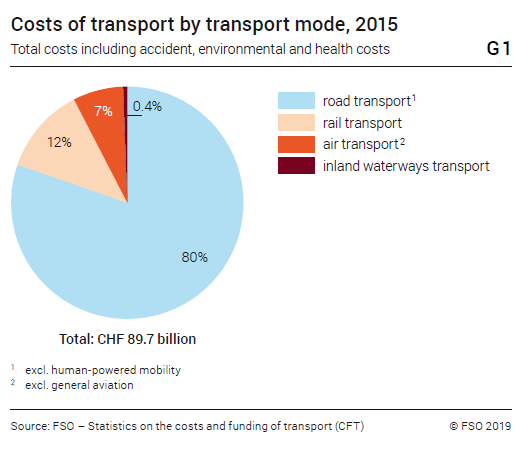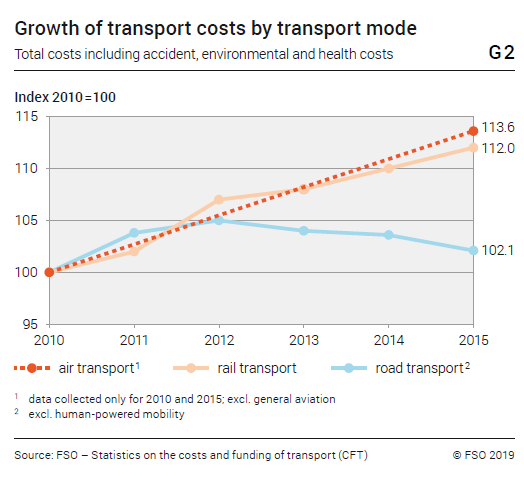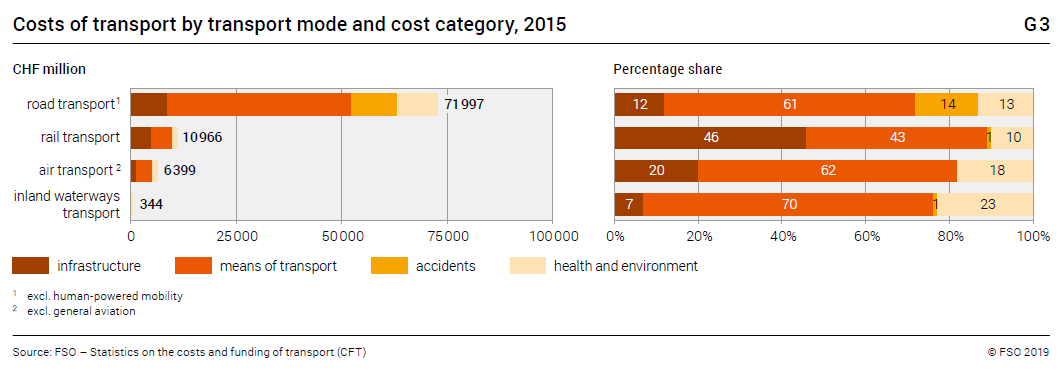| 08.04.2019 – In 2015, transport in Switzerland generated economic costs of around CHF 90 billion. This was 4% more than in 2010. Aviation (+14%) and rail transport (+12%) recorded the largest increases. In comparison, costs for motorised road transport remained rather stable (+2%) and accounted for four fifths of the total transport costs. None of the various transport user groups fully funded the generated costs themselves. These are the latest figures on the costs and funding of transport from the Federal Statistical Office (FSO).
Motorised transport by land, air and water generated economic costs of a total of CHF 89.7 billion in Switzerland in 2015. This corresponded to approximately CHF 11 000 per capita of the population. Three quarters of the costs were from passenger transport and a quarter from goods transport. The most expensive mode of transport was the road with a cost share of 80%. This mode of transport did, however, handle the greatest volume of transport by far. The cost shares of rail transport (12%), aviation (7%) and water transport (0.4%) were far lower. In comparison with 2010, transport costs rose by a total of 4%. There was a sharp increase in aviation (+14%) and in rail transport (+12%), whereas costs for motorised road transport rose only slightly (+2%). Growth drivers in aviation were the increase in passenger numbers (+27%), while in rail transport extensive investments were made. Comparing all modes of transport, expenditure on means of transport was by far the largest cost item with 59%. The maintenance and expansion of the transport infrastructure accounted for 17% of the total costs in 2015, while transport accidents made up 12% and transport-related damage to the environment and health 13%. |
Costs of transport by transport mode, 2015 |
| The general public also contributes
The costs are not only paid or borne by the users themselves but also by the state and the general public, i.e. by persons uninvolved in transport who have to suffer from its negative impacts. The road recorded the highest share of user funding at 86%. Nevertheless, the general public faced costs of CHF 8.6 billion through road transport in 2015 – due in particular to accidents and transport-related damage to the environment and health. This meant that the burden imposed by road transport on the general public was almost four times as great as all other modes of transport put together. Rail transport is supported by the state to ensure comprehensive coverage and with the aim of transferring transport flows from the road onto rail. In 2015, at CHF 4.7 billion, the Confederation, cantons and communes assumed almost as much of the costs as the passengers themselves (CHF 5 billion). In five year comparison, the state was, however, able to reduce its funding share by 2 percentage points to 43% which in return led to an increase in user funding to 46%. In aviation, passengers covered 81% of the total cost via ticket prices. The remaining CHF 1.1 billion had to be borne by the general public – mainly resulting from environmental damage. |
Growth of transport costs by transport mode |
| CHF 26 billion for passenger cars
In 2015, Swiss residents spent CHF 26.1 billion on the purchase, operation and maintenance of passenger cars alone. On average, this corresponded to 46 cents for every vehicle kilometre covered in Switzerland. If the infrastructure costs and accident costs from passenger cars and the transport-related damage to the environment and health are included, the total costs amount to 79 cents per car kilometre. In 2010, this value was 85 cents. The decrease was mainly due to lower accident costs. Sharp cost increase for vans In 2015, total costs from goods transport of CHF 20.9 billion were generated, CHF 18.6 billion of which was caused by road transport and CHF 2.2 billion by rail transport. What is noticeable is that transport by light road vehicles – mostly vans – has increased in cost by 18% since 2010, while the costs for heavy goods transport with lorries and road tractors have remained around the same (+1%). This is due to the sharp increase in transport in the delivery van sector. Low cost transport on the Rhine The costs for freight shipping on the Rhine were calculated for the first time for 2015. These amounted to CHF 144 million. Due to large tonnages and low infrastructure costs, the kilometre costs of Rhine shipping at 7 cents per freight tonne were far lower than those for transport by rail (17 cents) or heavy road vehicles (55 cents). However, Rhine barges may only be used for transport in the import and export sector. |
Costs of transport by transport mode and cost category, 2015 |
Road transport creates more climate damage than aviation
Costs for transport-related damage to the environment and health totalled CHF 11.8 billion with motorised road transport accounting for the majority of this at 89% or CHF 9.5 billion. CHF 3.3 billion of this amount was due to air pollutant emissions from road transport, another CHF 2.2 billion due to noise and CHF 1.6 billion due to climate-related costs from greenhouse gas emissions. The climate costs of road transport were thus in absolute figures around twice as high as those from aviation (CHF 0.8 billion). Proportionally, however, climate damage from aviation was far greater (13% compared with 3% in road transport).
Download press release: Transport costs have increased by 4% within five years
Full story here Are you the author? Previous post See more for Next postTags: newsletter



























